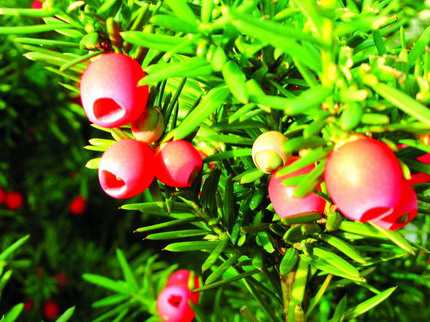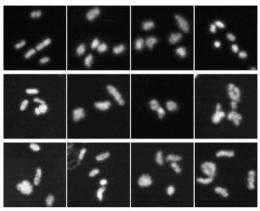JBC:发现癌细胞抗紫杉醇作用的生物标记
2012-04-10 Deepblue 生物谷
紫杉醇是红豆杉属植物中的一种复杂的次生代谢产物, 也是目前所了解的惟一一种可以促进微管聚合和稳定已聚合微管的药物。临床研究表明,紫杉醇是乳腺癌的有效抑制药物。尽管如此,癌细胞抗紫杉醇作用目前仍然是一个主要的临床挑战。当前,急需更好的理解紫杉醇抗性表型来发现能够预测肿瘤对紫杉醇应答的生物标记物。近日,美国乔治敦大学的Ayesha N. Shajahan等人发现,在雌性激素受体α (ER+)乳腺癌细胞

紫杉醇是红豆杉属植物中的一种复杂的次生代谢产物, 也是目前所了解的惟一一种可以促进微管聚合和稳定已聚合微管的药物。临床研究表明,紫杉醇是乳腺癌的有效抑制药物。尽管如此,癌细胞抗紫杉醇作用目前仍然是一个主要的临床挑战。当前,急需更好的理解紫杉醇抗性表型来发现能够预测肿瘤对紫杉醇应答的生物标记物。近日,美国乔治敦大学的Ayesha N. Shajahan等人发现,在雌性激素受体α (ER+)乳腺癌细胞中,当应答于低剂量(10nM)的紫杉醇时,小窝蛋白1(CAV1)的Y14结构域被磷酸化,导致BCL2的磷酸化水平提升,结果线粒体发生凋亡。相关研究发表在3月20日美国《生化周刊》(Journal of Biological Chemistry)上。
CAV1存在两种突变体,包括全长形式的CAV1α (野生型CAV1或者是wtCAV1)以及缩短形式的CAV1β,只有wtCAV1在N端有Y14结构域。CAV1突变体在细胞内的精确功能还未可知。Ayesha N. Shajahan发现,CAV1突变体在由紫杉醇介导的细胞凋亡以及细胞存活中起着完全不同的作用。与对紫杉醇敏感的细胞相比较,在紫杉醇抗性的细胞中CAV1β水平被显著提升。
在对紫杉醇敏感的细胞中,CAV1β的表达显著的降低了它们对紫杉醇的应答能力。这些过程反应了Y14的磷酸化具有重要作用。wtCAV1表达后,会磷酸化Y14结构域,结果激活氨基末端激酶 (JNK),钝化BCL2 and BCLxL。表达Y14F(缺陷的Y14结构)的MCF-7细胞会抗紫杉醇,但是可以通过ABT-737(一种BH3类似的小分子抑制物)的联合治疗而重新获得对紫杉醇的敏感性。
使用结构同源建模,研究人员发现Y14结构的磷酸化使得蛋白以一种有利构象去结合CAV1支架结构域(CSD)。因此,研究人员着重突出了CAV1突变体在细胞死亡中的新奇作用:即wtCAV1会促进细胞死亡;然而在紫杉醇介导的细胞凋亡中,通过JNK钝化BCL2及BCLxL,CAV1β促进了细胞存活。(生物谷Deepblue编译)

doi: 10.1074/jbc.M111.304022
PMC:
PMID:
Tyrosine phosphorylated caveolin-1 (Y14) increases sensitivity to paclitaxel by inhibiting BCL2 and BCLxL via JNK
Ayesha N. Shajahan, Zachary C. Dobbin, F. Edward Hickman, Sivanesan Dakshanamurthy and Robert Clarke.
Paclitaxel, an anti-microtubule agent, is an effective chemotherapeutic drug in breast cancer. Nonetheless, resistance to paclitaxel remains a major clinical challenge. The need to better understand the resistant phenotype, and to find biomarkers that could predict tumor response to paclitaxel is urgent. In estrogen receptor α (ER+) breast cancer cells, phosphorylation of caveolin-1 (CAV1) on Y14 facilitates mitochondrial apoptosis by increasing BCL2 phosphorylation in response to low dose paclitaxel (10 nM).Two variants of CAV1 exist; the full-length form CAV1α (wild-type CAV1 or wtCAV1) and a truncated form CAV1β. The precise cellular functions of CAV1 variants are unknown. Only wtCAV1 has the Y14 region at the N-terminus and we now show that CAV1 variants play distinct roles in paclitaxel-mediated cell death/survival. CAV1β is increased in paclitaxel-resistant cells compared to that in sensitive cells.Expression of CAV1β in sensitive cells significantly reduces their responsiveness to paclitaxel. These activities reflect the essential role for Y14 phosphorylation since wtCAV1 expression, but not a phosphorylation-deficient mutant (Y14F), inactivates BCL2 and BCLxL through activation of c-jun N-terminal kinase (JNK). MCF-7 cells that express Y14F are resistant to paclitaxel and are re-sensitized by co-treatment with ABT-737, a BH3-mimetic small molecule inhibitor.Using structural homology modeling, we propose that phosphorylation on Y14 enables a favorable conformation for proteins to bind to the CAV1 scaffolding domain (CSD). Thus, we highlight novel roles for CAV1 variants in cell death: wtCAV1 promotes cell death whereas CAV1β promotes cell survival by preventing inactivation of BCL2 and BCLxL via JNK in paclitaxel-mediated apoptosis
本网站所有内容来源注明为“梅斯医学”或“MedSci原创”的文字、图片和音视频资料,版权均属于梅斯医学所有。非经授权,任何媒体、网站或个人不得转载,授权转载时须注明来源为“梅斯医学”。其它来源的文章系转载文章,或“梅斯号”自媒体发布的文章,仅系出于传递更多信息之目的,本站仅负责审核内容合规,其内容不代表本站立场,本站不负责内容的准确性和版权。如果存在侵权、或不希望被转载的媒体或个人可与我们联系,我们将立即进行删除处理。
在此留言














#JBC#
68
#癌细胞#
63
#生物标记#
79